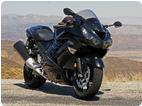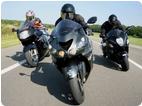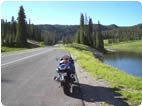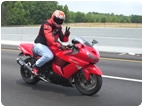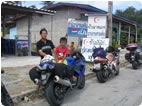I love all four of the Pit Bull products I own. Although I have listed a number of grips below, the trailer restraint system has also impressed me a great deal. Pit Bull is the only company I am aware of that has designed a stand that goes on a trailer. That application has some inherent difficulties that do not apply to ordinary stands used for working on and storing bikes. It is understandable that this product has some quirks compared to all of the other Pit Bull Products which are as close to perfect as you could expect. I want to tell the whole story but I also must stress that using straps alone would result in much more serious concerns than I had with the Pit Bull trailer restraint system.
Pit Bull Trailer Restraint Product Review
This product does exactly what it claims: once bolted to the trailer bed, it securely holds your bike up without the use of straps.
The trailer restraint mounting plate is bolted to the trailer bed. There are LH and RH locking mechanisms that attach to the mounting plate by spring loaded pin locks.
The stand itself is a bar that attaches to each side of the axle via axle pins which are specifically shaped to fit axle holes for the bike you intend to transport. On each side, a large retainer pin with a locking spring clip holds each axle pin securely into the stand.
The stand is attached to the rear axle, pivoted upward away from the ground and then suspended on a bungee that hooks to an exhaust hanger or other point on the back of the bike. The bike is loaded onto the trailer and the bungee is unhooked so that the stand can roll over the trailer bed on the two small wheels the stand is equipped with. The bike needs to be centered, parallel and perpendicular while it is rolled forward so that the stand will slide into the forks on the locking mechanisms squarely. The bike is now held upright on both of its wheels by the stand and the locking mechanism. Each locking mechanism has a lever that is pivoted down to hold the stand in place. A hitch pin is inserted through each lever and clipped to hold the levers shut. The bike is now ready to transport.
The stand can also be situated so that it engages the locking mechanisms in front of the rear wheel if you prefer.
The spring loaded pin locks on the locking mechanisms can be disengaged for quick removal and transferred to a second mounting plate located at a different location if you like.
Pins that fit the axle of another bike will fit into any Pit Bull Trailer Restraint stand. All you need to do to haul your other bike is buy the proper pins and you can use all of the other equipment with either set of pins. If you need to haul both bikes at the same time, you need two complete trailer restraint systems.
Pros
It works. It is virtually impossible for the bike to roll on the bed or tip over. It will not fall off the trailer bed even if the trailer tips over.
No straps are necessary so there is no concern about a strap coming loose or breaking. There is no chance any surfaces will be scuffed by straps and no concern about stress to the suspension from compression under straps.
Interchangeable parts. You can use a single trailer restraint system for any bike provided you purchase the correct pins for those bikes. You do not even need to unbolt the trailer restraint system from a trailer bed to use it somewhere else as long as you have purchased a second mounting plate and bolted it where you want to transfer the other parts.
It looks cool. For sure, it plain just looks badass!
Cons
Handle drag. The rubber covered handle on the stand will almost definitely gouge into the pavement if you roll the bike backward down a ramp without the bungee holding the stand up off the ground. This situation is not hard to avoid if you are aware of it. It’s a gripe I have because the Pit Bull instructions do not tell you about it. I scuffed my brand new stand before I even got the bike loaded.
Swaying and banging in axle. I’ve never heard of a problem caused by this but it was a concern I had after practicing the use of this product. It’s true the trailer restraint system holds the bike up securely but it is not completely rigid. The axle pins fit close in the axle holes but allow some play. In addition, the axle pins do not fit absolutely tight to the stand, the stand does not fit absolutely tight to the locking mechanisms and the locking mechanisms do not fit absolutely tight to the mounting plate. This sounds like a severe problem but the bike only rocks a few degrees left and right. I still do not like that. It seems possible that the aluminum axle holes could expand after hammering and possibly twisting from repeatedly driving the trailer over bumps. A new axle might be necessary to restore a tight fit to the axle pins. The manufacturer suggested turning the steering full lock to make the bike tip to the opposite side thereby holding everything more tightly in place. I chose to use a set of Canyon Dancer handlebar straps along with the trailer restraint system instead. The straps were tightened just a little and straight out to the sides to hold the bike from swaying. They also help some to prevent the front of the bike from bouncing up off the bed. Canyon Dancers seemed to solve the potential rear axle beating problem and to me. The setup is much preferable to using straps to hold the bike down against the suspension.
Precision of centering. It’s not really a gripe but more just a fact that you must have the bike positioned nearly perfect in order to properly slide the stand into the locking mechanisms. It is a lot more difficult to do this after rolling the bike up a ramp and then having very little space to roll the bike on center. This is even harder if you intend to use a wheel chock that'll require both front and rear wheels be centered. To me, it is worth the time to know my bike will not be damaged from straps but centering the stand on the locking mechanisms is a cumbersome task.
Cost of extra axle pins. Its very doubtful the axle pins will ever wear out but you might loose them and you might need to purchase a second set for a different bike. This will cost you about one hundred dollars/set of pins! They are nothing special, just a couple steel pins with plastic handles and retainer pins with wire spring clips, each weighing about 4 oz.
Threaded handles on axle pins. They are threaded into the steel pins and used to put the pins into the axle hole. If you twist them at all, they will thread loose. Will they rattle loose and fall out while rolling down the road? That never happened to me but you can be sure I will try some locktite on those handles next time I use the TRS.
Flimsy hitch pins. OK, it’s a hitch pin but they could have made it a bit more hefty for the price of this product. I stepped on one while it was installed and it bent very easily. I bent it back but now the metal is fatigued. A hitch pin made of something more than the ~1/16” stock they use would not bend in most situations that are likely to happen.
Conclusion The Pit Bull TRS is not easy to use but it is the safest option for transporting a bike. It is much preferable to straps alone.
Knowing the reputation of Pit Bull, this product which has been on the market without change since at least 2008 must have been tested and made as perfect as it possibly can be. I think the locking mechanisms being welded instead of removable might make a very small improvement in rigidity but that is the tradeoff for being able to easily transfer the whole system to another mounting plate if you need to do that. There is no getting around the play in the axle holes. The axle pins can only be made so tight before that becomes an installation problem. I consider strapping the handlebars laterally a wise precaution when using this product. Although it doubles the difficulty of positioning the bike, some sort of wheel chock may also be of benefit to help prevent the front of the bike from bouncing up, shifting and then twisting the rear axle hole against the pins. I used the Pit Bull wheel chock and it did seem to be immobilizing the bike a bit more than the trailer restraint alone.
* Last updated by: Rook on 8/5/2019 @ 2:39 PM *
